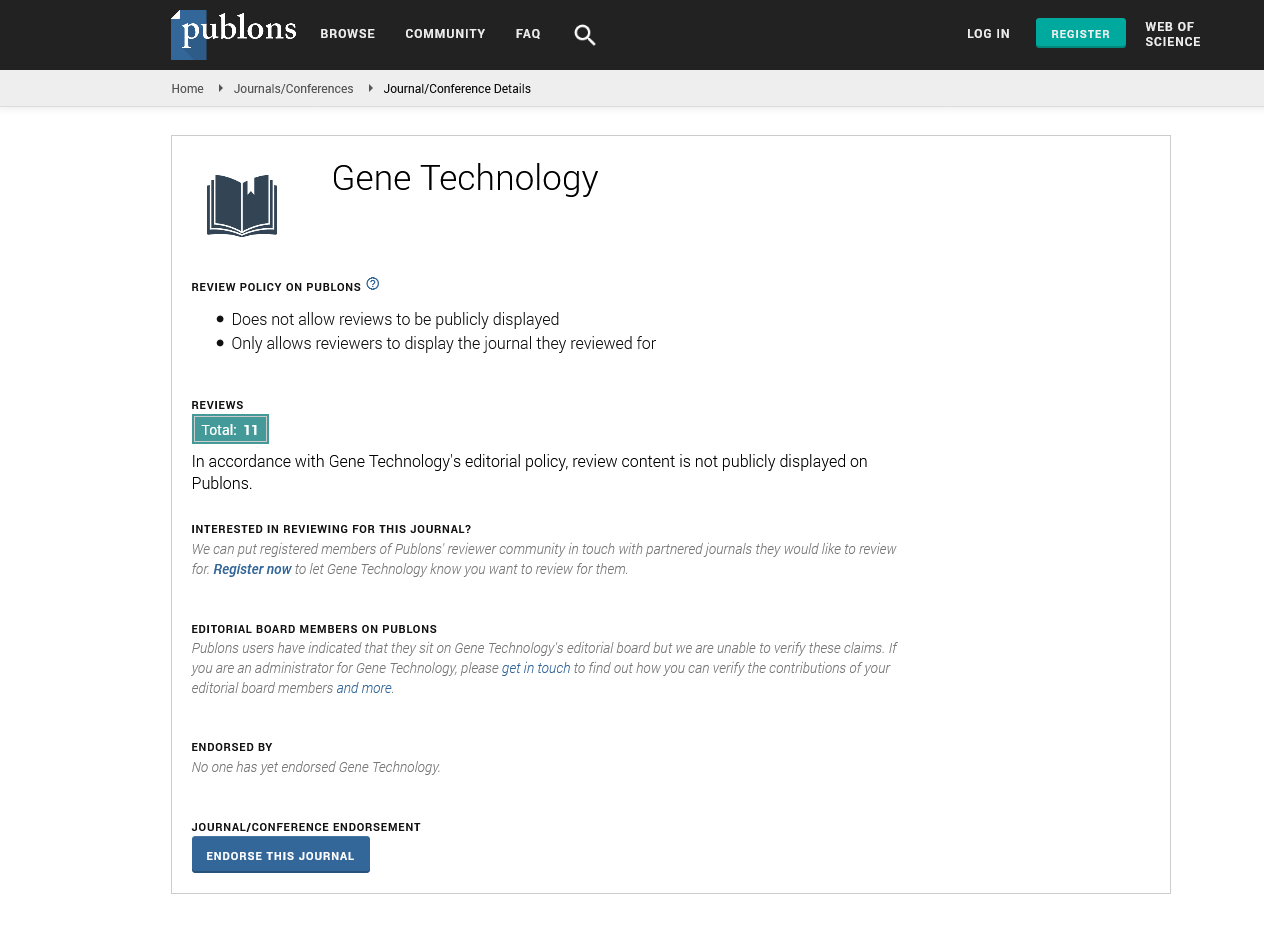Indexed In
- Academic Keys
- ResearchBible
- CiteFactor
- Access to Global Online Research in Agriculture (AGORA)
- RefSeek
- Hamdard University
- EBSCO A-Z
- OCLC- WorldCat
- Publons
- Euro Pub
- Google Scholar
Useful Links
Share This Page
Journal Flyer

Open Access Journals
- Agri and Aquaculture
- Biochemistry
- Bioinformatics & Systems Biology
- Business & Management
- Chemistry
- Clinical Sciences
- Engineering
- Food & Nutrition
- General Science
- Genetics & Molecular Biology
- Immunology & Microbiology
- Medical Sciences
- Neuroscience & Psychology
- Nursing & Health Care
- Pharmaceutical Sciences
Perspective - (2024) Volume 13, Issue 2
Gene Technology and Its Role in Multipathogen Resistance and Applications
Hannah Richard*Received: 03-Jun-2024, Manuscript No. RDT-24-26176; Editor assigned: 06-Jun-2024, Pre QC No. RDT-24-26176 (PQ); Reviewed: 20-Jun-2024, QC No. RDT-24-26176; Revised: 27-Jun-2024, Manuscript No. RDT-24-26176 (R); Published: 04-Jul-2024, DOI: 10.35248/2329-6682.24.13.281
Description
Advancements in gene technology have revolutionized the field of biotechnology, particularly in enhancing resistance to multiple pathogens across various organisms. Multipathogen resistance is the ability of an organism to resist infections from different pathogens simultaneously. This trait is especially in agriculture, medicine, and public health, where pathogens pose significant challenges to crop yields, human health, and disease management. The development and application of gene technology in achieving multipathogen resistance have opened new avenues for sustainable and resilient practices.
Gene technology includes a range of techniques used to manipulate the genetic material of organisms to achieve desired traits. These techniques include gene editing tools like CRISPRCas9, RNA interference (RNAi), and transgenic approaches. By enabling precise modifications in the genome, these technologies allow experts to enhance or introduce traits such as disease resistance, improved yield, and stress tolerance. CRISPR-Cas9, a groundbreaking gene-editing tool, has significantly accelerated the development of multipathogen-resistant organisms. This technology allows for precise and targeted modifications in the genome, enabling the insertion, deletion, or alteration of specific genes associated with pathogen resistance. In agriculture, CRISPR-Cas9 has been employed to develop crops resistant to multiple pathogens. For example, inventors have used CRISPR to edit genes in rice plants, making them resistant to bacterial blight and blast fungus, two major pathogens that cause significant yield losses. Similarly, in animals, CRISPR has been utilized to enhance resistance to viral infections, such as porcine reproductive and respiratory syndrome in pigs.
RNA interference (RNAi) is another powerful tool in gene technology that can be used to achieve multipathogen resistance. RNAi works by silencing specific genes, preventing the production of proteins necessary for pathogen survival and replication. This method has been successfully applied in plants to develop resistance against viruses, fungi, and insects. For instance, RNAi has been used to confer resistance in potatoes against late blight, a devastating disease caused by Phytophthora infestans. By silencing genes essential for the pathogen's lifecycle, scientists have created potato varieties that can withstand infections, reducing the need for chemical fungicides.
Transgenic technology involves the introduction of foreign genes into an organism's genome to express desired traits. This approach has been instrumental in developing multipathogen resistant crops by combining genes from different sources that confer resistance to various pathogens. A important example is the development of transgenic cotton plants resistant to both insect pests and viral diseases. By incorporating genes from Bacillus thuringiensis (Bt) for insect resistance and viral coat protein genes for virus resistance, scientists have created cotton varieties that can withstand multiple threats. This technology has significantly reduced the reliance on chemical pesticides, promoting sustainable agriculture and reducing environmental impact. The application of gene technology in agriculture has led to the development of crops with enhanced multipathogen resistance, which is critical for ensuring food security and sustainable farming practices.
Gene technology also in the medical field for combating infectious diseases in humans. By understanding the genetic basis of pathogen resistance, researchers can develop novel therapies and vaccines to prevent and treat infections. For instance, gene editing techniques like CRISPR are being explored to develop antiviral therapies that target and disable viral genes, providing a potential cure for diseases such as HIV and hepatitis B. Moreover, gene technology can be used to enhance the immune system's ability to fight off multiple pathogens. Scientists are investigating the use of gene editing to modify immune cells, making them more effective in recognizing and eliminating infections.
In public health, gene technology can be utilized to prevent the spread of infectious diseases through vector control. For example, gene editing has been used to create genetically modified mosquitoes that are resistant to malaria parasites. Similarly, gene technology can be applied to control other vector-borne diseases such as dengue, Zika, and chikungunya by modifying the genes of vectors like mosquitoes to make them less capable of transmitting these pathogens. This approach offers a sustainable method for disease control, reducing the burden on public health systems. Gene technology has revolutionized the field of biotechnology, offering innovative solutions for achieving multipathogen resistance in various organisms. Through techniques like CRISPR-Cas9, RNA interference, and transgenic approaches, experts have made significant strides in developing crops, animals, and medical therapies that can withstand infections from multiple pathogens. These advancements have deep implications for agriculture, medicine, and public health, promoting sustainable practices and improving disease management.
Citation: Richard H (2024) Gene Technology and Its Role in Multipathogen Resistance and Applications. Gene Technol. 13:281.
Copyright: © 2024 Richard H. This is an open-access article distributed under the terms of the Creative Commons Attribution License, which permits unrestricted use, distribution, and reproduction in any medium, provided the original author and source are credited.

